Experimental Investigation of the Explosion Effects on Reinforced Concrete Slabs with Fibers
Abstract
1. Introduction
2. Materials and Methods
2.1. RC Slab Specimens’ Description
2.2. Calculation of Quantity of Explosives
2.3. Selected NDT
2.3.1. Schmidt Hammer
2.3.2. Electrical Resistivity of Concrete
2.3.3. Velocity of the Ultrasonic Wave
2.4. NDT Methodology
3. Results and Discussion
3.1. Visual Inspection
3.2. Schmidt Hammer Measurements
3.3. Electrical Resistivity of Concrete
3.4. Velocity of the Ultrasonic Wave
3.5. Comprehensive Analysis of the Results
4. Conclusions
- The method for calculating the required amount of explosives for the demolition of a conventionally reinforced concrete element can also be used for RC elements with fibers if the proportion of fibers in the concrete is low, as in this study. With a larger proportion of added fibers, the mass of the explosive must be increased if the same damage effect is to be achieved. It is recommended to further investigate the influence of the fiber content on the required amount of explosive to achieve the same demolition objectives as with a classical reinforced concrete element.
- Visual inspection and measurement of dimensions amount to a sufficient method for the evaluation of external damage to RC due to explosion.
- Three non-destructive testing methods, the Schmidt hammer, a device for measuring the electrical resistivity of concrete, and ultrasound, are used to assess internal damage (changes in the concrete microstructure, cracks, voids, etc.) in the RC concrete slabs before and after an explosion. Of the methods used, the use of ultrasound proved to be the best as changes in the microstructure of the concrete, e.g., micro- and macrocracks, reduce the velocity of the ultrasonic waves through the thickness of the concrete slabs.
- With the same amount of explosive, RC slabs with steel and polypropylene fibers have better resilience to contact detonation than RC slabs without fibers. The difference can be observed in the smaller areas of punctured concrete at the edge of the slab and spalled concrete on the unloaded side of the slab due to the higher tensile strength of concrete with added fibers.
- The analysis of the internal damage to the samples is based on the measurement of the velocity of the ultrasonic wave passing through the slab thickness before and after the explosion and the calculated value of the dynamic modulus of elasticity. For RC slabs with the same amount of explosive, the ultrasonic wave velocity is decreased by 17% for samples without fibers and with steel fibers and by 29% for samples with polypropylene fibers. The reduction in the dynamic modulus of elasticity after the explosion is even more pronounced: for RC slabs without fibers and steel fibers, the reduction is 27%, and, for RC slabs with polypropylene fibers, it is 47%. The much greater deterioration in RC slabs with polypropylene fibers is a consequence of the low resistance of polypropylene fibers to the high temperatures that develop in the RC slabs during an explosion.
- When analyzing samples with the same composition of concrete and the same amount of explosive but different compressive strengths of the concrete, no significant differences in their resistance to the effects of the explosives are found.
- In the analysis of slabs with steel fibers with different amounts of explosives, the greatest difference is found in the percentage of punctured concrete at the edges of the slabs, which is nine times higher in the RC slab with a triple amount of explosives than in the RC slab with a standard amount of explosives, while other damage indicators show similar values or deterioration by 50 to 100%.
- Since it has been found that concrete with steel fibers provides greater resistance to destruction by explosives, this should be considered in the design of civil and military structures to protect personnel, property, and strategically important facilities. This approach would increase the resilience of buildings to the effects of explosions, reduce the potential for disasters and casualties, and raise the protection and safety of personnel and material in these structures to a higher level.
Author Contributions
Funding
Data Availability Statement
Acknowledgments
Conflicts of Interest
References
- Smolčić, Ž.; Ožbolt, J. Meso scale model for fiber-reinforced-concrete: Microplane based approach. Comput. Concr. 2017, 19, 375–385. [Google Scholar] [CrossRef]
- Marcalikova, Z.; Racek, M.; Mateckova, P.; Cajka, R. Comparison of tensile strength fiber reinforced concrete with different types of fibers. Procedia Struct. Integr. 2020, 28, 950–956. [Google Scholar] [CrossRef]
- Kohoutková, A.; Broukalová, I. Optimization of Fibre Reinforced Concrete Structural Members. Procedia Eng. 2013, 65, 100–106. [Google Scholar] [CrossRef]
- Ztürk, B.; Yilmaz, C. Analytical investigation of effect of retrofit application using CFRP on seismic behavior of a monumental building at historical Cappadocia region of Turkey. In Proceedings of the 9th US National and 10th Canadian Conference on Earthquake Engineering, Toronto, ON, Canada, 25–29 July 2010; pp. 25–29. [Google Scholar]
- Mostafaei, H.; Bahmani, H.; Mostofinejad, D.; Wu, C. A novel development of HPC without cement: Mechanical properties and sustainability evaluation. J. Build. Eng. 2023, 76, 107262. [Google Scholar] [CrossRef]
- Li, Y.F.; Ramanathan, G.K.; Syu, J.Y.; Huang, C.H.; Tsai, Y.K. Mechanical behavior of different fiber lengths mix-proportions carbon fiber reinforced concrete subjected to static, impact, and blast loading. Int. J. Prot. Struct. 2024, 15, 43–64. [Google Scholar] [CrossRef]
- Li, Y.; Aoude, H. Effects of stainless steel reinforcement and fibers on the flexural behaviour of high-strength concrete beams subjected to static and blast loading. Eng. Struct. 2023, 291, 116398. [Google Scholar] [CrossRef]
- Zhao, H.; Zhao, X.; Fang, H.; Yang, L.; Sun, J.; Liu, S.; Liu, Z. Experimental investigation of steel fiber reinforced concrete slabs subjected to underwater contact explosions. Ocean Eng. 2023, 281, 114664. [Google Scholar] [CrossRef]
- Abedini, M.; Zhang, C. Dynamic performance of ultra-high performance fiber-reinforced concrete panel exposed to explosive loading. Int. J. Prot. Struct. 2023. [CrossRef]
- Zhao, X.; Sun, J.; Zhao, H.; Jia, Y.; Fang, H.; Wang, J.; Yao, Y.; Wei, D. Experimental and mesoscopic modeling numerical researches on steel fiber reinforced concrete slabs under contact explosion. Structures 2024, 61, 106114. [Google Scholar] [CrossRef]
- Tauma, W.K.; Balázs, L.G. Impact and blast resistance of slurry infiltrated fiber concrete (SIFCON): A comprehensive review. Concr. Struct. 2023, 24, 129–136. [Google Scholar] [CrossRef]
- Milić, P.; Kušter Marić, M. Climate change effect on durability of bridges and other infrastructure. Građevinar 2023, 75, 893–906. [Google Scholar] [CrossRef]
- Orcesi, A.; Diamantidis, D.; O’Connor, A.; Palmisano, F.; Sykora, M.; Boros, V.; Caspeele, R.; Chateauneuf, A.; Ivanković Mandić, A.; Lenner, R.; et al. Investigating Partial Factors for the Assessment of Existing Reinforced Concrete Bridges. Struct. Eng. Int. 2023, 34, 55–70. [Google Scholar] [CrossRef]
- Rassoulpour, S.; Shiravand, M.R.; Safi, M. Proposed seismic-resistant dual system for continuous-span concrete bridges using self-centering cores. Eng. Struct. 2023, 274, 115181. [Google Scholar] [CrossRef]
- Shirkhani, H.; Lounis, Z.; Zhang, J. Life-cycle design of concrete highway bridge decks under climate change. In Life-Cycle of Structures and Infrastructure Systems, 1st ed.; Biondini, F., Frangopol, D.M., Eds.; CRC Press: London, UK, 2023; pp. 1609–1616. [Google Scholar]
- Kušter Marić, M.; Ožbolt, J.; Balabanić, G.; Zhychkovska, O.; Gambarelli, S. Chloride Transport in Cracked Concrete Subjected to Wetting—Drying Cycles: Numerical Simulations and Measurements on Bridges Exposed to De-Icing Salts. Front. Built Environ. 2020, 6, 561897. [Google Scholar] [CrossRef]
- Figueiredo, E.; Santos, L.O.; Moldovan, I.; Kraniotis, D.; Melo, J.; Dias, L.; Coelho, G.B. A roadmap for an integrated assessment approach to the adaptation of concrete bridges to climate change. J. Bridge Eng. 2023, 28, 03123002. [Google Scholar] [CrossRef]
- Wujian, Y.; Xinxin, T.; Zhijian, W.; Ping, W.; Lin, K. Seismic response of concrete bridge of Lanzhou-Xinjiang high-speed railway under the near-fault strong earthquake. Structures 2023, 50, 1416–1428. [Google Scholar] [CrossRef]
- Borah, M.M.; Sil, A. Service-Life Estimation of a Reinforced Concrete Bridge Structure Exposed to Chloride-Contaminated Environments and Variable Traffic Loads. ASCE ASME J. Risk Uncertain. Eng. Part A Civ. Eng. 2023, 9, 04023028. [Google Scholar] [CrossRef]
- Stewart, M.G.; Thöns, S.; Beck, A.T. Assessment of risk reduction strategies for terrorist attacks on structures. Struct. Saf. 2023, 104, 102353. [Google Scholar] [CrossRef]
- Ahmad, J.; Zhou, Z. Waste marble based self compacting concrete reinforced with steel fiber exposed to aggressive environment. J. Build. Eng. 2024, 81, 108142. [Google Scholar] [CrossRef]
- Yang, J.; Chen, R.; Zhang, Z.; Zou, Y.; Zhou, J.; Xia, J. Experimental study on the ultimate bearing capacity of damaged RC arches strengthened with ultra-high performance concrete. Eng. Struct. 2023, 279, 115611. [Google Scholar] [CrossRef]
- Qiu, Z.; Prabhakaran, A.; Su, L.; Zheng, Y. Performance-based seismic resilience and sustainability assessment of coastal RC bridges in aggressive marine environments. Ocean Eng. 2023, 279, 114547. [Google Scholar] [CrossRef]
- Holland, B.; Alapati, P.; Kurtis, K.E.; Kahn, L. Effect of different concrete materials on the corrosion of the embedded reinforcing steel. In Corrosion of Steel in Concrete Structures, 2nd ed.; Poursaee, A., Ed.; Woodhead Publishing: Sawston, UK, 2023; pp. 199–218. [Google Scholar]
- Hu, J.; Deng, Y.; Jiao, W.; Yao, Y.; Chen, D. Dynamic response and damage assessment of a prestressed T-shaped simply supported girder bridge under contact explosion. Structures 2023, 48, 40–52. [Google Scholar] [CrossRef]
- Xiao, Y.; Zhu, W.; Li, M.; Jia, J.; Li, Z. Concrete spalling behavior and damage evaluation of concrete members with different cross-sectional properties under contact explosion. Int. J. Impact Eng. 2023, 181, 104753. [Google Scholar] [CrossRef]
- Kušter Marić, M.; Ožbolt, J.; Balabanić, G. Reinforced concrete bridge exposed to extreme maritime environmental conditions and mechanical damage: Measurements and numerical simulation. Eng. Struct. 2020, 205, 110078. [Google Scholar] [CrossRef]
- Zircher, T.; Keuser, M.; Burbach, A.; Lehmann, S. Protective components made of steel fiber reinforced concrete under contact detonation. Procedia Eng. 2017, 199, 2525–2530. [Google Scholar] [CrossRef]
- Kovar, M.; Foglar, M.; Hajek, R. The blast performance of real-scale reinforced concrete specimens with varying fiber types and content. WIT Trans. Built Environ. 2014, 141, 159–169. [Google Scholar] [CrossRef]
- Foglar, M.; Kovar, M. Conclusions from experimental testing of blast resistance of FRC and RC bridge decks. Int. J. Impact Eng. 2013, 59, 18–28. [Google Scholar] [CrossRef]
- Foglar, M.; Kovar, M. Spalling of concrete subjected to blast loading. In Proceedings of the 3rd International Workshop on Concrete Spalling Due to Fire Exposure, Paris, France, 25–27 September 2013; Volume 6, p. 07005. [Google Scholar] [CrossRef]
- Yang, D.; Zhang, B.; Liu, G. Experimental Study on Spall Resistance of Steel-Fiber Reinforced Concrete Slab Subjected to Explosion. Int. J. Concr. Struct. Mater. 2021, 15, 23. [Google Scholar] [CrossRef]
- Matković, A. Blast Loading on the Reinforced Concrete Bridge Deck. Bachelor’s Thesis, University of Zagreb, Zagreb, Croatia, September 2020. Available online: https://urn.nsk.hr/urn:nbn:hr:249:827337 (accessed on 11 January 2024). (In Croatian).
- Matković, A. Explosive Effect on Reinforced Concrete Slabs with Fibers. Master’s Thesis, University of Zagreb, Zagreb, Croatia, 2021. Available online: https://urn.nsk.hr/urn:nbn:hr:249:290250 (accessed on 11 January 2024). (In Croatian).
- Matković, A. Influence of Concrete Mixture and Quality on Damage of Reinforced Concrete Slabs Due to Blast Loading. Master’s Thesis, University of Zagreb, Zagreb, Croatia, July 2021. (In Croatian). [Google Scholar]
- HRN EN 206-1:2006; Concrete—Part 1: Specification, Performance, Production and Conformity (Includes Amendments A1:2004 and A2:2005) (EN 206-1:2000+A1:2004+A2:2005). CSI: Zagreb, Croatia, 2006.
- HRN EN 12390-3:2019; Testing Hardened Concrete—Part 3: Compressive Strength of Test Specimens. CSI: Zagreb, Croatia, 2019.
- Horvat, V. Demolition Tables. Croatian Military Academy “Dr. Franjo Tuđman”, February 2016. Available online: https://vojni.unizg.hr/ (accessed on 11 January 2024). (In Croatian).
- Horvat, V. Demolition of Elements and Materials. Lessons, Croatian Military Academy “Dr. Franjo Tuđman”, February 2016. Available online: https://vojni.unizg.hr/ (accessed on 11 January 2024). (In Croatian).
- Horvat, V. Theory of Demolition of Elements and Materials. Lectures on Military Practice, Croatian Military Academy “Dr. Franjo Tuđman”, March 2020. Available online: https://vojni.unizg.hr/ (accessed on 11 January 2024). (In Croatian).
- Li, J.; Wu, C.; Hao, H. Spallation of reinforced concrete slabs under contact explosion. In Proceedings of the Second Asian Conference on Defence Technology, Chiang Mai, Thailand, 21–23 January 2016. [Google Scholar] [CrossRef]
- Kušter Marić, M.; Vlašić, A.; Ivanković, A.M.; Bleiziffer, J.; Srbić, M.; Skokandić, D. Assessment of reinforcement corrosion and concrete damage on bridges using non-destructive testing. Građevinar 2019, 71, 843–862. [Google Scholar] [CrossRef]
- Pečur, I.B. Application of non-destructive testing in civil engineering. HDKBR INFO Magazin 2013, 3, 2–9. Available online: https://hrcak.srce.hr/148799 (accessed on 29 December 2023).
- Pečur, I.B.; Štirmer, N.; Galić, J. Testing polymer modified concrete by non-destructive methods. Građevinar 2009, 61, 655–662. Available online: https://hrcak.srce.hr/en/clanak/63636 (accessed on 29 December 2023).
- Cleven, S.; Raupach, M.; Matschei, T. Electrical Resistivity of Steel Fibre-Reinforced Concrete—Influencing Parameters. Materials 2021, 14, 3408. [Google Scholar] [CrossRef] [PubMed]
- Turk, K.; Cicek, N.; Katlav, M.; Donmez, I.; Turgut, P. Electrical conductivity and heating performance of hybrid steel fiber-reinforced SCC: The role of high-volume fiber and micro fiber length. J. Build. Eng. 2023, 76, 107392. [Google Scholar] [CrossRef]
- Li, J.; Wu, C.; Hao, H. Investigation of ultra-high performance concrete slab and normal strength concrete slab under contact explosion. Eng. Struct. 2015, 102, 395–408. [Google Scholar] [CrossRef]
- Foglar, M.; Hajek, R.; Fladr, J.; Pachman, J.; Stoller, J. Full-scale experimental testing of the blast resistance of HPFRC and UHPFRC bridge decks. Constr. Build. Mater. 2017, 145, 588–601. [Google Scholar] [CrossRef]
- Draganić, H.; Gazić, G.; Varevac, D. Experimental investigation of design and retrofit methods for blast load mitigation–A state-of-the-art review. Eng. Struct. 2019, 190, 189–209. [Google Scholar] [CrossRef]
- Silva, P.; Lu, B. Improving the blast resistance capacity of RC slabs with innovative composite materials. Compos. B. Eng. 2007, 38, 523–534. [Google Scholar] [CrossRef]
- Drdlová, M.; Buchar, J.; Krátký, J.; Řídký, R. Blast resistance characteristics of concrete with different types of fibre reinforcement. Struct. Concr. 2015, 16, 508–517. [Google Scholar] [CrossRef]
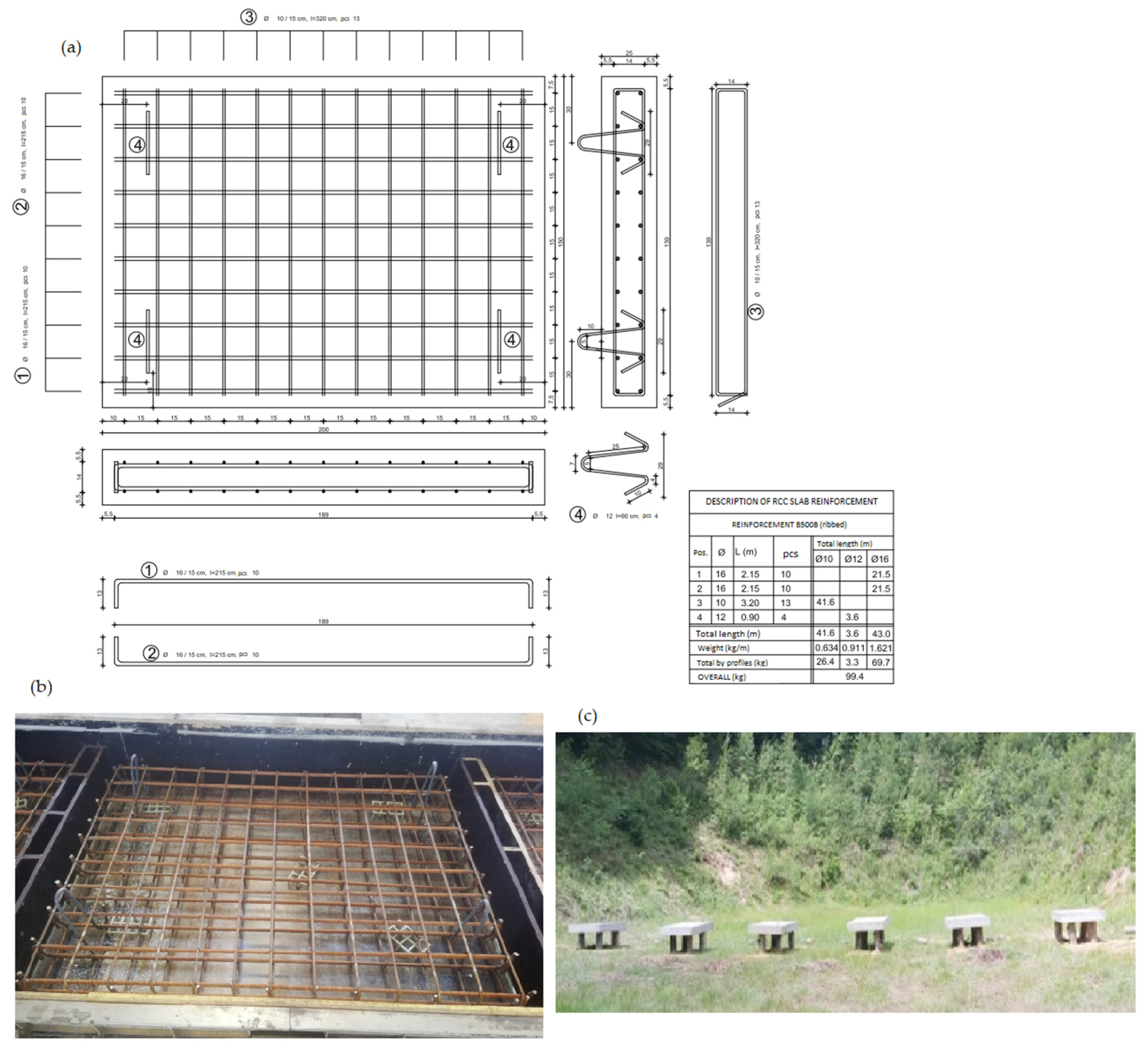
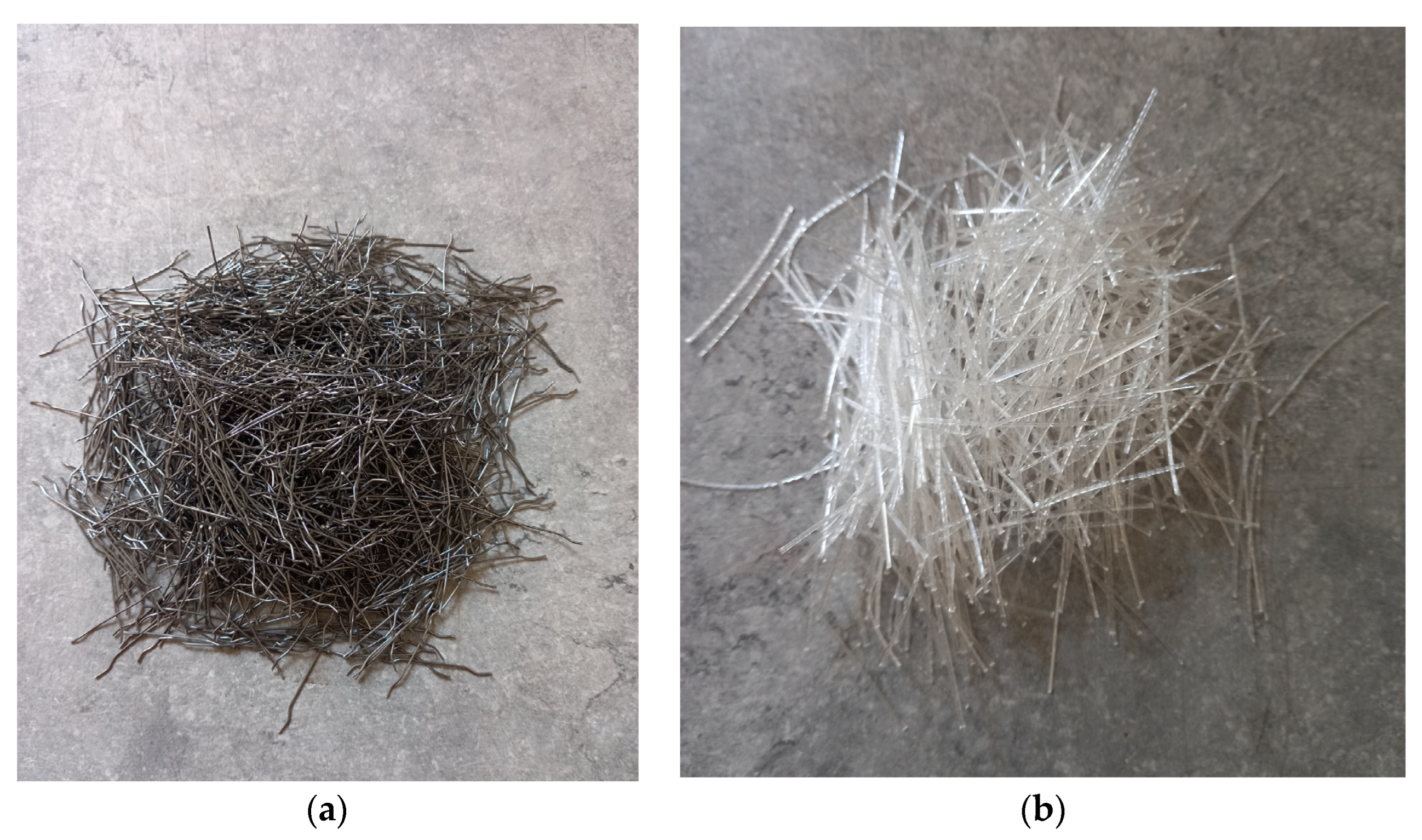
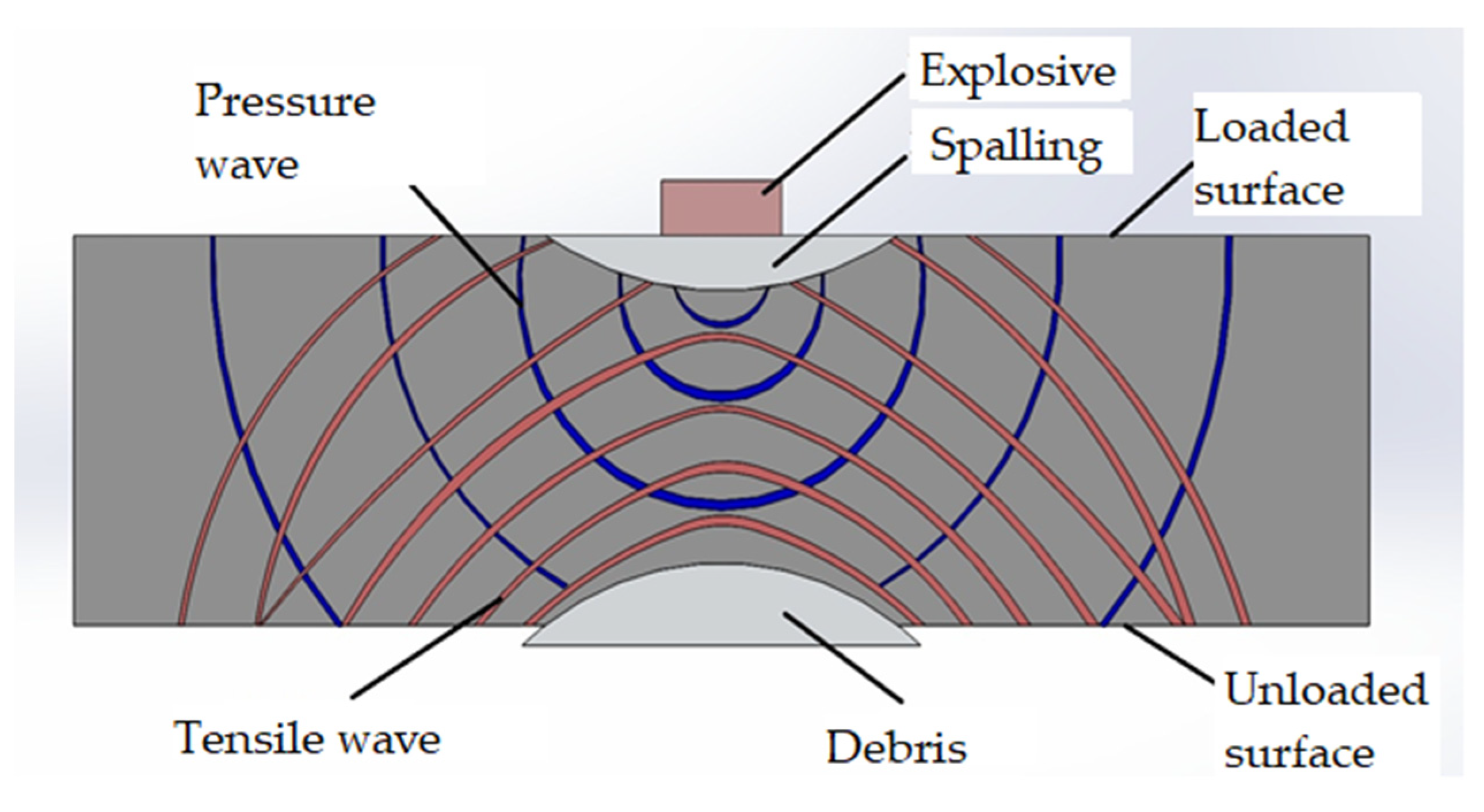

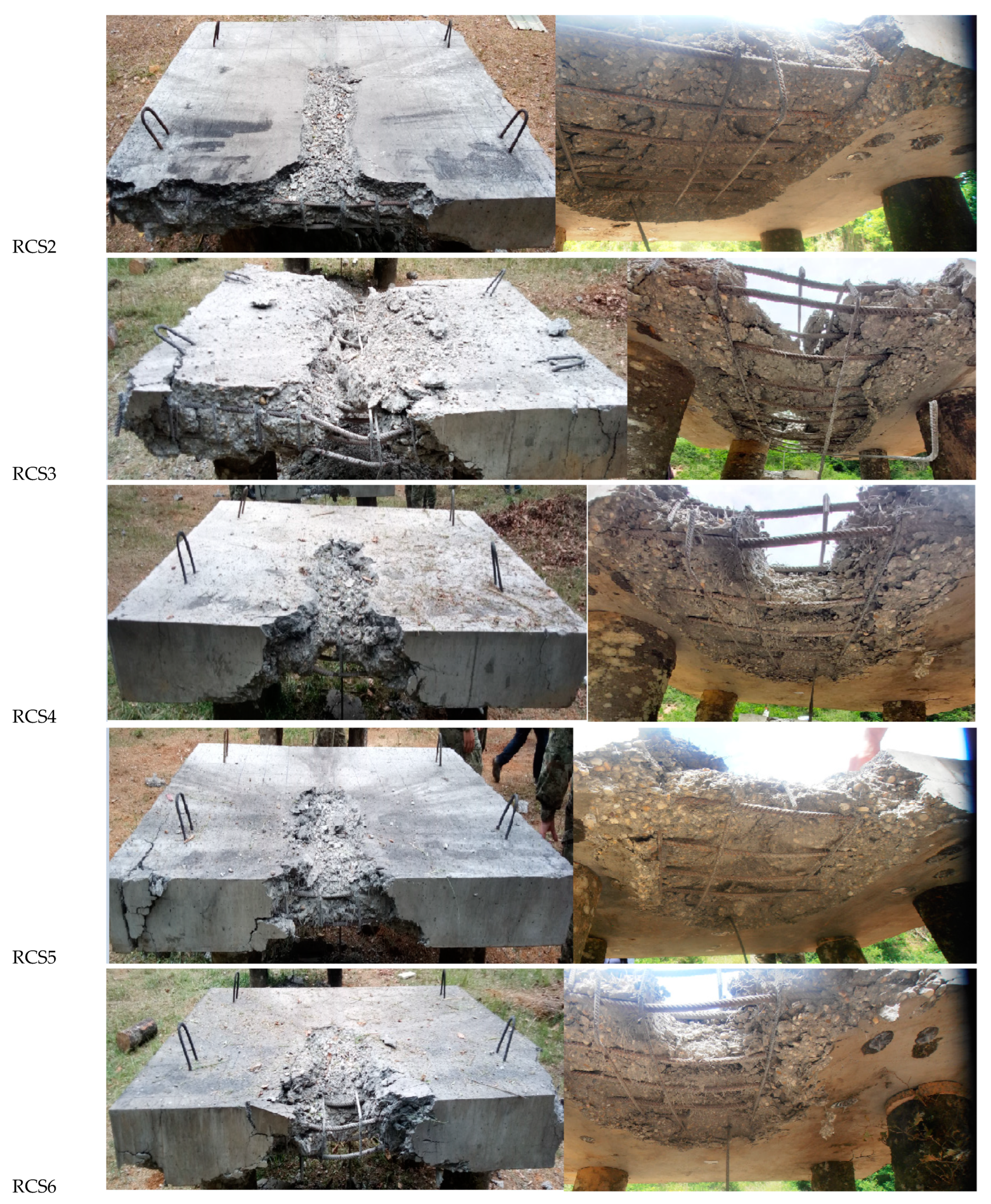
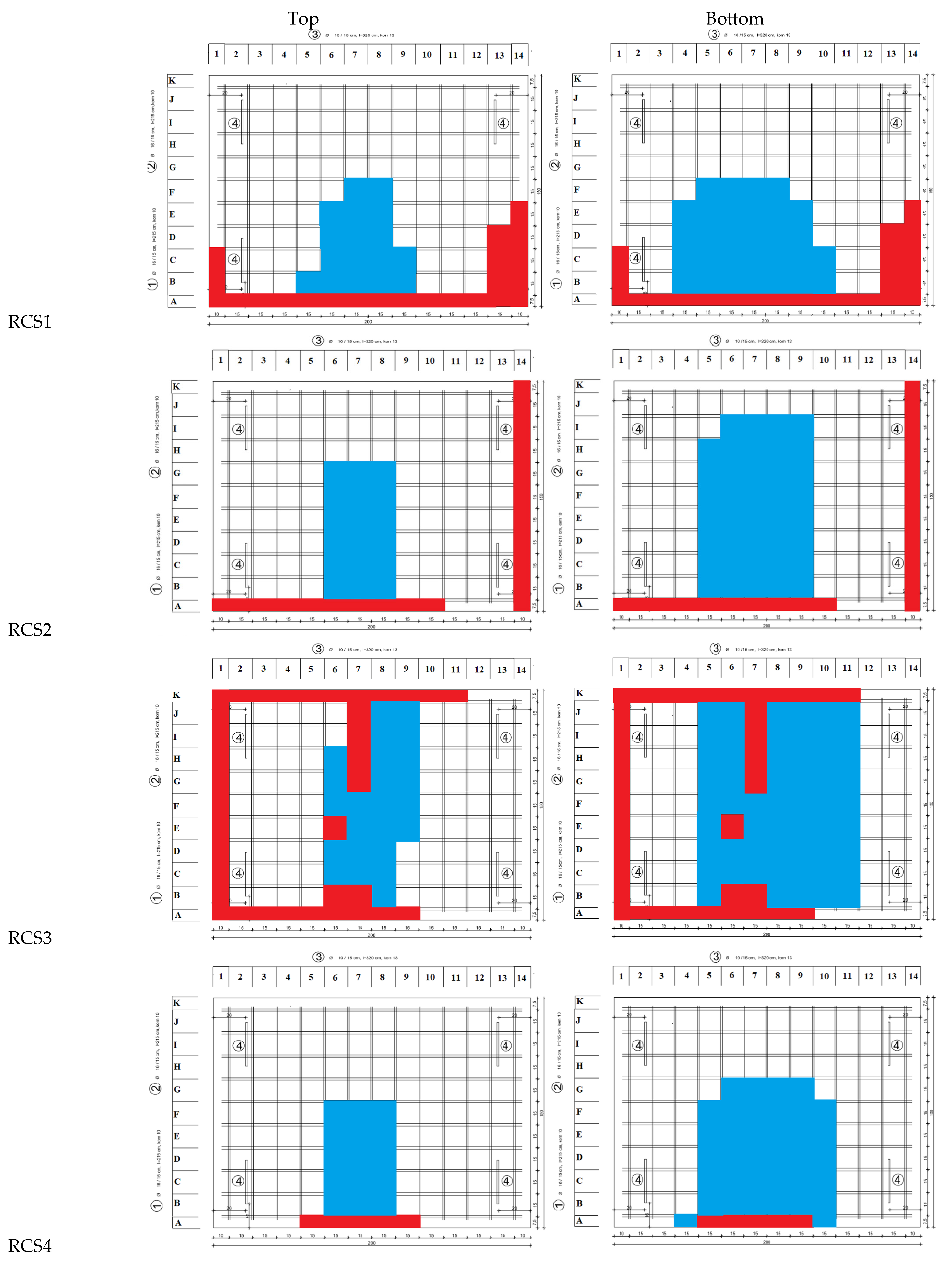






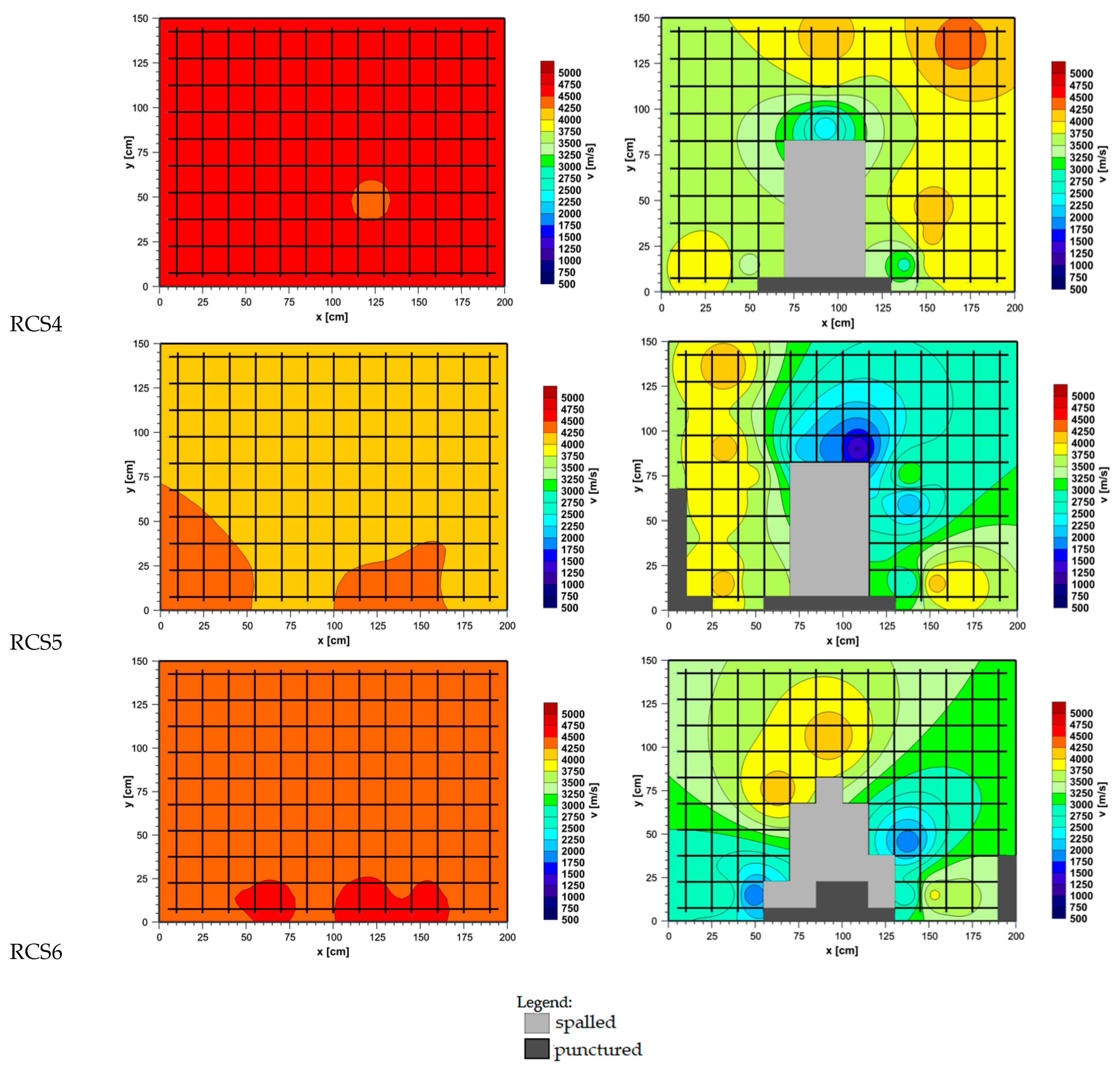
| Specimen Number | Designed Class of Concrete (Characteristic Cylinder/Cube Compressive Strength) | Realized Class of Concrete (Characteristic Cylinder/Cube Compressive Strength) | Designation of the Specimen in the Following Text | Steel Fibers (25 mm, 400 MPa) | Polypropylene Fibers (54 mm, 600–800 MPa) | Amount of Used Explosive [kg TNT] |
|---|---|---|---|---|---|---|
| 1 | C30/37 | C40/50 | RCS1 | - | - | 2.8 |
| 2 | C50/60 | C50/60 | RCS2 | - | - | 3.3 |
| 3 | C30/37 | C35/45 | RCS3 | 80 kg/m3 | - | 8.8 |
| 4 | C50/60 | C50/60 | RCS4 | 80 kg/m3 | - | 2.8 |
| 5 | C30/37 | C35/45 | RCS5 | - | 9 kg/m3 | 2.8 |
| 6 | C50/60 | C50/60 | RCS6 | - | 9 kg/m3 | 3.4 |
| Compressive Strength [N/mm2] | RCS1 | RCS2 | RCS3 | RCS4 | RCS5 | RCS6 |
|---|---|---|---|---|---|---|
| Sample 1, fci,cube | 50.8 | 64.1 | 52.7 | 66.8 | 52.1 | 65.8 |
| Sample 2, fci,cube | 53.0 | 65.4 | 55.3 | 64.1 | 50.6 | 63.1 |
| Sample 3, fci,cube | 54.5 | 60.7 | 55.1 | 65.6 | 48.9 | 64.6 |
| Mean value, fcm,cube | 52.7 | 63.4 | 54.3 | 65.5 | 50.5 | 64.5 |
| Component * | Specimens | Type | Mass [kg] per 1 m3 of Concrete | Density [kg/m3] |
|---|---|---|---|---|
| Cement | RCS1, RCS3, RCS5 | CEM II/A-LL 42.5 R | 400 | 3010 |
| RCS2, RCS4, RCS6 | CEM I 42.5 R | 450 | 3010 | |
| Aggregate | RCS1, RCS3, RCS5 | quarry “Arkada” Zvečaj, Dmax = 16 mm | 1855 | - |
| RCS2, RCS4, RCS6 | 1835 | - | ||
| w/c | RCS1, RCS3, RCS5 | - | 0.45 | - |
| RCS2, RCS4, RCS6 | - | 0.35 | - | |
| Superplasticizer | RCS1, RCS3, RCS5 | ViscoCrete-20 Gold | 1.61 | - |
| RCS2, RCS4, RCS6 | 3.63 | - |
| Velocity of the Ultrasonic Wave [m/s] | Concrete Quality |
|---|---|
| >4000 | Good |
| 3000–4000 | Medium |
| <3000 | Bad |
| Specimen | Surface | Spalled Surface [m2] | Spalled Surface [%] | Punctured Surface [m2] | Punctured Surface [%] | Damaged Surface in Total [m2] | Damaged Surface in Total [%] |
|---|---|---|---|---|---|---|---|
| RCS1 | Top | 0.3825 | 12.75 | 0.3075 | 10.25 | 0.69 | 23.00 |
| Bottom | 0.675 | 22.50 | 0.9825 | 32.75 | |||
| RCS2 | Top | 0.405 | 13.50 | 0.25875 | 8.63 | 0.66375 | 22.13 |
| Bottom | 0.8775 | 29.25 | 1.13625 | 37.88 | |||
| RCS3 | Top | 0.54 | 18.00 | 0.51 | 17.00 | 1.05 | 35.00 |
| Bottom | 1.26 | 42.00 | 1.77 | 59.00 | |||
| RCS4 | Top | 0.3375 | 11.25 | 0.05625 | 1.88 | 0.39375 | 13.13 |
| Bottom | 0.7875 | 26.25 | 0.84375 | 28.13 | |||
| RCS5 | Top | 0.3375 | 11.25 | 0.135 | 4.50 | 0.4725 | 15.75 |
| Bottom | 0.54 | 18.00 | 0.675 | 22.50 | |||
| RCS6 | Top | 0.315 | 10.50 | 0.13875 | 4.63 | 0.45375 | 15.13 |
| Bottom | 0.5175 | 17.25 | 0.65625 | 21.88 |
| Specimen | RCS1 | RCS2 | RCS3 | RCS4 | RCS5 | RCS6 | |||||||
|---|---|---|---|---|---|---|---|---|---|---|---|---|---|
| Measurement time relative to the explosion: | before | after | before | after | before | after | before | after | before | after | before | after | |
| Rebound value, Q [−] | min | 48.8 | 47.2 | 54.8 | 50.7 | 46.5 | 31.0 | 47.8 | 47.6 | 21.9 | 46.5 | 53.5 | 39.8 |
| max | 66.3 | 64.3 | 65.1 | 64.2 | 57.7 | 55.5 | 59.5 | 58.5 | 55.2 | 60.5 | 62.4 | 62.8 | |
| mean | 59.6 | 58.6 | 61.6 | 60.9 | 52.9 | 47.2 | 54.6 | 54.9 | 50.7 | 53.4 | 58.7 | 55.8 | |
| st. dev. | 3.1 | 4.1 | 2.2 | 3.1 | 2.3 | 6.7 | 2.4 | 2.7 | 4.6 | 2.9 | 2.0 | 5.5 | |
| Electrical resistivity, ρ [Ωm] | min | 76.0 | 60.7 | 72.3 | 59.0 | 25.3 | 30.7 | 22.7 | 20.7 | 55.7 | 45.0 | 65.0 | 52.3 |
| max | 106.7 | 156.7 | 94.0 | 110.0 | 49.7 | 94.0 | 38.3 | 49.3 | 65.3 | 90.3 | 82.3 | 130.7 | |
| mean | 87.9 | 82.3 | 81.3 | 84.3 | 36.3 | 61.9 | 30.8 | 31.9 | 61.1 | 60.4 | 72.2 | 75.7 | |
| st. dev. | 8.4 | 21.1 | 4.7 | 12.5 | 5.9 | 16.8 | 3.9 | 6.6 | 2.5 | 11.2 | 5.4 | 20.5 | |
| Velocity of ultrasonic wave, v [m/s] | min | 4071 | 428 | 4424 | 3096 | 4125 | 133 | 4496 | 2363 | 4118 | 1230 | 4432 | 1836 |
| max | 4521 | 4409 | 4596 | 4194 | 4562 | 3381 | 4604 | 4355 | 4363 | 4222 | 4545 | 4145 | |
| mean | 4298 | 3696 | 4535 | 3733 | 4388 | 1803 | 4543 | 3728 | 4255 | 3231 | 4479 | 3118 | |
| st. dev. | 95 | 1237 | 52 | 389 | 125 | 1386 | 32 | 605 | 97 | 1031 | 45 | 950 | |
| Dynamic modulus of elasticity, Ed [MPa] | min | 37.01 | 0.41 | 43.70 | 21.40 | 37.99 | 0.04 | 45.14 | 12.47 | 37.86 | 3.38 | 43.86 | 7.53 |
| max | 45.64 | 43.41 | 47.17 | 39.28 | 46.47 | 25.52 | 47.33 | 42.35 | 42.50 | 39.80 | 46.12 | 38.36 | |
| mean | 41.25 | 30.50 | 45.92 | 31.12 | 42.99 | 7.26 | 46.08 | 31.03 | 40.43 | 23.31 | 44.79 | 21.71 | |
| st. dev. | 0.91 | 10.21 | 0.53 | 3.24 | 1.22 | 5.58 | 0.32 | 5.04 | 0.92 | 7.44 | 0.45 | 6.61 | |
Disclaimer/Publisher’s Note: The statements, opinions and data contained in all publications are solely those of the individual author(s) and contributor(s) and not of MDPI and/or the editor(s). MDPI and/or the editor(s) disclaim responsibility for any injury to people or property resulting from any ideas, methods, instructions or products referred to in the content. |
© 2024 by the authors. Licensee MDPI, Basel, Switzerland. This article is an open access article distributed under the terms and conditions of the Creative Commons Attribution (CC BY) license (https://creativecommons.org/licenses/by/4.0/).
Share and Cite
Kušter Marić, M.; Ivanović, A.; Fusić, M.; Srbić, M.; Vlašić, A. Experimental Investigation of the Explosion Effects on Reinforced Concrete Slabs with Fibers. Buildings 2024, 14, 1080. https://doi.org/10.3390/buildings14041080
Kušter Marić M, Ivanović A, Fusić M, Srbić M, Vlašić A. Experimental Investigation of the Explosion Effects on Reinforced Concrete Slabs with Fibers. Buildings. 2024; 14(4):1080. https://doi.org/10.3390/buildings14041080
Chicago/Turabian StyleKušter Marić, Marija, Anđela Ivanović, Mladen Fusić, Mladen Srbić, and Anđelko Vlašić. 2024. "Experimental Investigation of the Explosion Effects on Reinforced Concrete Slabs with Fibers" Buildings 14, no. 4: 1080. https://doi.org/10.3390/buildings14041080
APA StyleKušter Marić, M., Ivanović, A., Fusić, M., Srbić, M., & Vlašić, A. (2024). Experimental Investigation of the Explosion Effects on Reinforced Concrete Slabs with Fibers. Buildings, 14(4), 1080. https://doi.org/10.3390/buildings14041080









